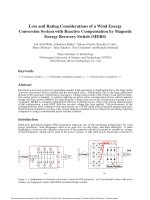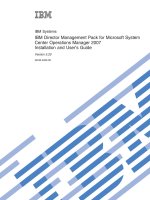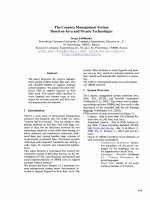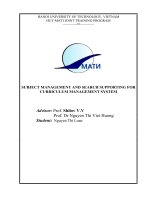M6 Energy Management System And Plan - Imo Ttt Course Presentation Final1.Ppt
Bạn đang xem bản rút gọn của tài liệu. Xem và tải ngay bản đầy đủ của tài liệu tại đây (2.68 MB, 83 trang )
Module 6:
Energy Management
Plan and System
IMO Train the Trainer Course
Name of the Presenter
Affiliation of the presenter,
City, Country
Energy Efficient Ship Operation
Venue, City, Country
Day xx to Day yy, Month, Year
Content
Overview of management systems
ISO 50001 on Energy Management System (EnMS)
IMO SEEMP
Company Energy Management System (CEnMS)
Ship energy audit and review
Ship performance monitoring
IMO data collection and EU MRV
Overview of Management Systems
Role of top management
The cornerstone of good management
is:
Commitment from the top
management; and
Dedication from the operating
personnel.
The ISM Code foundation is also based
on this paradigm and requires:
Management commitment.
Staff/personnel empowerment.
Continuous improvement.
PDCA and continuous improvement
PDCA is the most basic framework for any
management system.
Plan: An action plan of the activities that
need to be done together with all relevant
implementation details.
Do: The implementation of the selected
improvement measures.
Check: Monitor the results of the
implementation via effective data analysis
and assessments.
Act: The effectiveness of the plan is reviewed
and new targets are set for next PDCA cycle.
Management systems in shipping
ISM Code: The most prominent management
system that is already mandatory in shipping.
Safety is at its core.
ISO 9001: Quality Management System
ISO 140001: Environmental management system
OHSAS 18001: Health and safety systems.
ISO 50001: Energy management system.
ISM Code
A shipping-specific international
regulations with the ultimate objectives:
To ensure safety at sea.
To prevent human injury or loss of
life.
To avoid damage to the
environment and the ship.
ISM Code
In order to comply with the ISM code, each
ship must have a working Safety
Management System (SMS) to ensure:
Commitment from top management.
A “policy manual”.
A “procedures manual” that documents
the ship-board activities.
Procedures for conducting both internal
and external audits.
A designated person ashore to make
sure the SMS implementation.
A system for checking actual practices
versus planned.
Regular management reviews.
ISO 9001: Quality Management System (QMS)
The ISO 9000 series are related to
quality management systems.
Designed to help organizations
ensure that:
They meet the needs of their
clients/customers; and while
Meeting relevant statutory and
regulatory requirements.
The ISO 9001 is highly oriented
towards “process improvements” .
In shipping, many companies so far
have adopted the ISO 9001.
ISO 14001 - Environmental Management
System (EMS)
ISO 14000 series of standards relate to EMS
(Environmental Management System).
Designed to help organizations to minimize
the negative impacts of their operations on the
environment.
ISO 14001 requires the organization to
assess all of its “environmental aspects”.
ISO 140001 main requirement is that the
“significant environmental aspects” should be
identified, documented and
controlled/managed.
The latest version is ISO 14001:2015 includes
the concept of “continuous improvement”
approach.
OHSAS 18001: Occupational Health and
Safety Assessment Specification
OHSAS 18001 is a British Standard (BS)
that is used globally.
It deals with occupational health and
safety risks and their control.
OHSAS 18001 focuses on:
The need to identify all occupational
health and safety hazards
Carry out their relevant risk
assessment.
The OHSAS 18001 has been
harmonized with ISO 9001 and ISO
14001 to help organizations to integrate
the quality, environmental and safety
management systems.
/>
Commonalities
It can be demonstrated that all the
management standards have common
features in areas of:
Need for defining objectives and policies
Need for top management engagement
and commitment.
PDCA cycle approach for continuous
improvement
Need for training of human resources
Need for monitoring and inspection
Etc.
- 50001
Based on the above commonalities,
certification bodies provide an integrated
approach to their verification and certification.
ISO standards and ISM Code
ISM code is mandatory.
Anything included in a ship’s SMS will be regarded as mandatory.
ISO standards (9001, 14001, etc.) are not mandatory.
Care should be exercised not to cause complications with regard to
ISM related Flag State and Port State Control inspections.
Once an environmental / energy management procedure becomes
part of the ship’s SMS, it will become mandatory to follow the
processes even if the requirements are not mandatory.
ISO 50001 on Energy Management System
ISO 50001 energy management processes
Energy policy
Energy planning
Implementation
Checking
Management review
Source: ISO 50001:2011
ISO
50001 EnMS
requirements
Continuous
cycle and
content of ISO 50001
This shows the overall
content of the standard.
ISO 50001 sections and
clauses.
Continuous improvement
cycle.
The starting point is the
“energy policy”.
Company Energy Policy
Energy efficiency policy and commitment
Company
Company energy
energy policy
policy set
set
the
the agenda
agenda for
for control
control of
of GHG
GHG
emissions
emissions and
and fuel
fuel cost.
cost.
Main
Main questions:
questions:
What
What to
to be
be included?
included?
Whose
Whose responsibility?
responsibility?
Objectives
Objectives and
and targets?
targets?
Stakeholders
Stakeholders coordination?
coordination?
Employee
Employee training?
training?
Self
Self evaluation
evaluation and
and
improvement?
improvement?
Investment
Investment aspects?
aspects?
Etc.
Etc.
Energy efficiency policy and commitment
Commitment
Commitment from
from the
the top
top
management:
management:
Commitment
Commitment from
from the
the
management
management at
at the
the highest
highest
level
level should
should be
be demonstrated
demonstrated
via
via energy
energy policy
policy
endorsement
endorsement and
and
communication.
communication.
Energy efficiency policy and targets
Setting
Setting targets
targets and
and aims
aims
Commitment
Commitment is
is best
best to
to be
be
demonstrated
demonstrated by
by setting
setting
energy
energy efficiency
efficiency targets.
targets.
Quantitative
Quantitative to
to extent
extent
possible.
possible.









